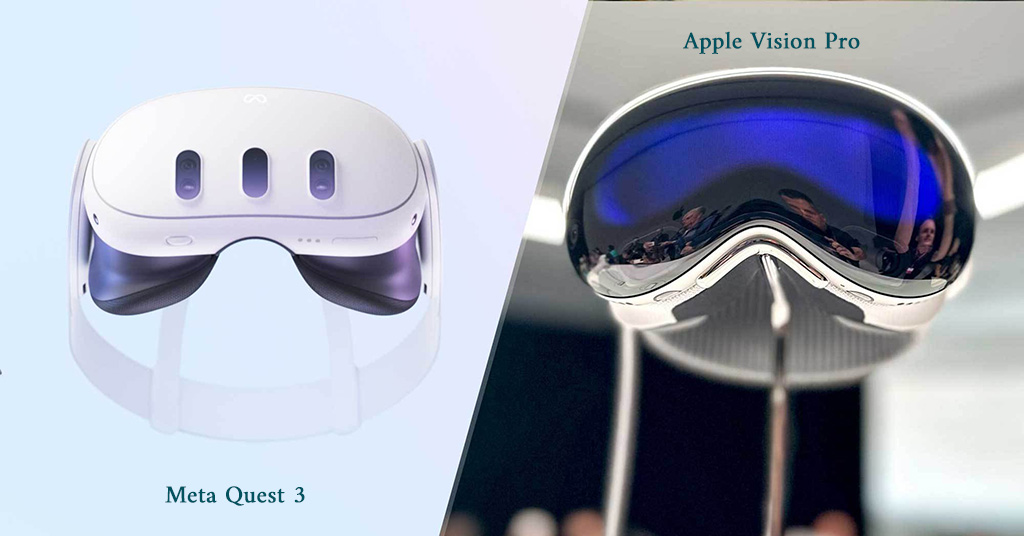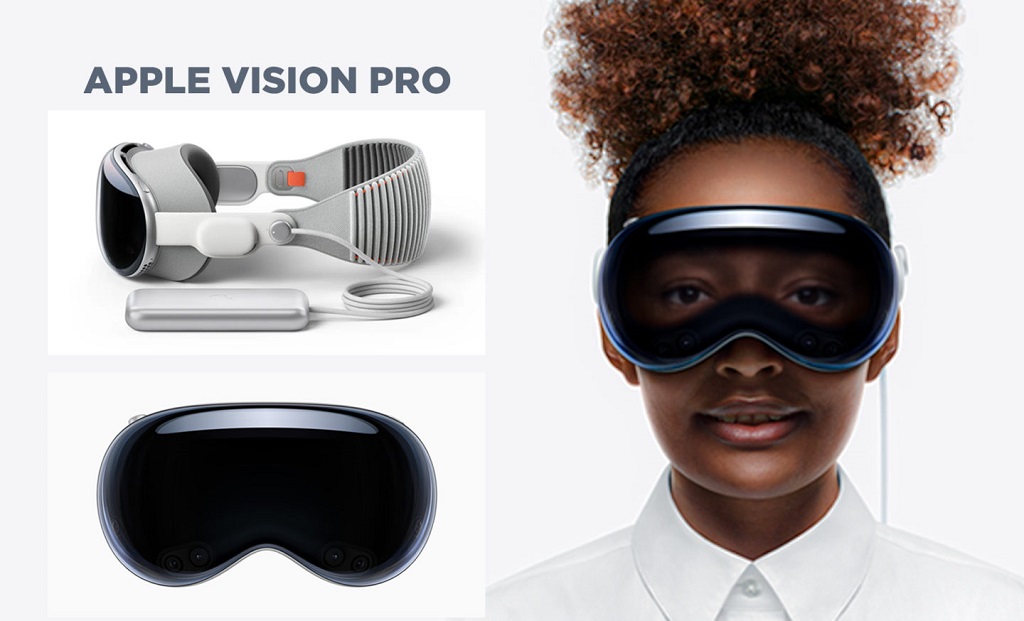Apple Vision Pro vs. Meta Quest 3: A Detailed Comparison
In the evolving world of virtual reality (VR) and augmented reality (AR), two headsets have emerged as significant contenders, setting new standards for immersive experiences: Apple’s Vision Pro and the Meta Quest 3. These devices cater to different segments of the market, offering unique features, technologies, and price points. This article delves into the intricacies of both headsets, comparing their design, display capabilities, audio features, mixed reality experiences, and performance to help you decide which one might be the best fit for your needs.
Introduction to the Contenders
Meta Quest 3
The latest iteration from Meta, the Quest 3, builds upon the success of its predecessors, offering improved optics, specs, and a wide range of VR and mixed reality (MR) experiences. Priced at an accessible $500, it’s celebrated for its balance between productivity and gaming, making it a versatile option for VR enthusiasts.
Apple Vision Pro
Apple’s foray into the VR/AR market introduces the Vision Pro, a device teeming with advanced technology and designed for premium entertainment and productivity experiences. With a significant price tag of $3,499, the Vision Pro is positioned as a luxury item, promising unparalleled immersive experiences.
Design and Comfort, Apple Vision Pro vs. Meta Quest 3
Both headsets feature distinct designs reflective of their brand’s philosophy. The Meta Quest 3 opts for a utilitarian approach with a white plastic front and a comfortable Y-style head strap designed to improve stability and comfort during use. It also offers an IPD adjustment wheel for personalized eye comfort.
The Apple Vision Pro, on the other hand, boasts a sleeker design with a black glass-like front, housing numerous sensors. It features a single strap system with an innovative Fit Dial for a secure fit, alongside an optional over-the-head strap for additional stability. The Vision Pro’s design emphasizes minimalism and functionality, integrating speakers and controls within the strap for a streamlined experience.
Display and Audio Quality
Display: The Meta Quest 3 utilizes dual LCD pancake lenses, offering a resolution of 2,064 x 2,208 pixels per eye, a 30% improvement over its predecessor. It supports a 120Hz refresh rate, providing a smooth visual experience.
Conversely, the Apple Vision Pro employs micro-OLED displays, boasting a staggering 23MP per eye, roughly translating to 4K resolution, but with a lower refresh rate of 90Hz. Despite the lower refresh rate, the micro-OLED technology ensures crisp, vibrant visuals, setting a new standard for display quality in VR headsets.
Audio: Both headsets feature integrated speakers within the headband, offering spatial audio for an immersive sound experience. The Meta Quest 3’s improved near-field speakers deliver loud, clear audio, while the Vision Pro introduces Personalized Spatial Audio, enhancing the immersion by adjusting the audio based on the user’s head movements.
Mixed Reality and Passthrough Cameras
The Meta Quest 3 and Apple Vision Pro put a significant emphasis on mixed reality experiences through their passthrough cameras. The Quest 3’s cameras provide natural color reproduction and decent sharpness in well-lit conditions, though performance in low light is noted as a limitation.
The Vision Pro, with its 12 cameras, five sensors, and six microphones, including LIDAR for 3D information, promises high-quality mixed reality experiences. Although detailed information about its camera performance has yet to be fully disclosed, Vision Pro’s emphasis on entertainment and productivity suggests a strong focus on delivering superior mixed reality experiences.
Performance and Software
Meta Quest 3: Powered by the Qualcomm Snapdragon XR2 Gen 2 and 8GB of RAM, the Quest 3 is touted as one of the most powerful standalone VR headsets, offering seamless gaming and mixed reality experiences. It operates on Meta’s Quest OS, providing a reliable and user-friendly interface.
Apple Vision Pro: The Vision Pro runs on VisionOS, powered by Apple’s M2 and R1 chips, promising unparalleled performance. While its gaming library may not be as extensive as the Quest 3’s, the Vision Pro is expected to excel in entertainment and productivity applications, backed by Apple’s reputation for superior software integration.
Price and Value
The pricing of these headsets underscores their target markets. The Meta Quest 3, at $500, is accessible to a broader audience, offering a balanced mix of gaming and productivity. The Apple Vision Pro, with its $3,499 price tag, caters to a premium segment seeking the ultimate in VR/AR experiences. Sell VR
Table summarizing the pros and cons of the Apple Vision Pro and Meta Quest 3:
| Feature | Apple Vision Pro | Meta Quest 3 |
| Price | – Hilariously expensive ($3,499) | – Much less expensive ($500) |
| Technology & Display | – Tons of impressive technology with micro-OLED displays (approximately 4K resolution per eye) | – Good optics and specs with dual LCD pancake lenses (2,064 x 2,208 pixels per eye) |
| Gaming | – Gaming could be challenging due to control limitations | – Good mixture of productivity and gaming with modern features |
| Mixed Reality & Passthrough | – Features like 360-video and advanced mixed reality experiences with 12 cameras, including LIDAR for capturing 3D information | – Camera passthrough for mixed reality experiences, though cameras have poor low-light performance |
| Productivity & Entertainment | – Outstanding for entertainment and productivity | – Balances productivity with a vast gaming library |
| Battery Life | – 2 hours (estimated), with a tethered battery pack | – 2.4 hours of gaming, slightly better than the Vision Pro |
| Connectivity & Storage | – Wi-Fi and Bluetooth, options for 1TB/2TB/4TB storage | – Wi-Fi 6E, Bluetooth 5.2, with 128GB/512GB storage options |
| Audio | – Two speakers with spatial audio, including Personalized Spatial Audio | – Improved near-field speakers for clear audio |
| Design & Comfort | – Sleeker look with an innovative strap design for comfort and stability | – Utilitarian design with a focus on stability and comfort, including IPD adjustment |
| Refresh Rate & Processor | – 90 Hz refresh rate with Apple M2 + Apple R1 processors | – 120Hz refresh rate with Qualcomm Snapdragon XR2 Gen 2 processor |
Table comparing the specifications of the Apple Vision Pro and Meta Quest 3:
| Feature | Apple Vision Pro | Meta Quest 3 |
| Resolution (per eye) | 23MP per eye, roughly 4K resolution | 2,064 x 2,208 pixels per eye |
| Display Type | Micro-OLED | Dual LCD, Pancake lenses |
| Storage | 1TB / 2TB / 4TB | 128GB / 512GB |
| Connectivity | Wi-Fi and Bluetooth | Wi-Fi 6E, Bluetooth 5.2 |
| Battery Life | 2 hours (estimated) | 2.4 hours gaming |
| Tracking Technology | LEDs and infrared cameras | N/A |
| Audio | Two speakers with spatial audio | Improved near-field speakers |
| Weight | ~1 pound (453 grams) | 515g |
| Refresh Rate | 90 Hz | 120Hz |
| Processor | Apple M2 + Apple R1 | Qualcomm Snapdragon XR2 Gen 2 |
| RAM | Unknown | 8GB |
Conclusion: Choosing the Right Headset
The choice between the Apple Vision Pro and Meta Quest 3 depends on individual needs, budget, and what you value most in a VR/AR experience. The Meta Quest 3 offers an affordable entry into high-quality VR, making it an excellent choice for gaming and everyday VR experiences. Meanwhile, the Apple Vision Pro is a technological marvel, promising unmatched display quality and immersive experiences for those willing to invest in premium AR/VR technology. https://www.apple.com/shop/buy-vision
Both headsets demonstrate the rapid advancements in VR/AR technology, each excelling in their respective areas. Whether you prioritize gaming, mixed reality experiences, or the sheer luxury of cutting-edge technology, there’s a headset tailored to your preferences. As the VR/AR space continues to evolve, the Apple Vision Pro and Meta Quest 3 stand as testaments to the innovation driving the future of immersive experiences.



